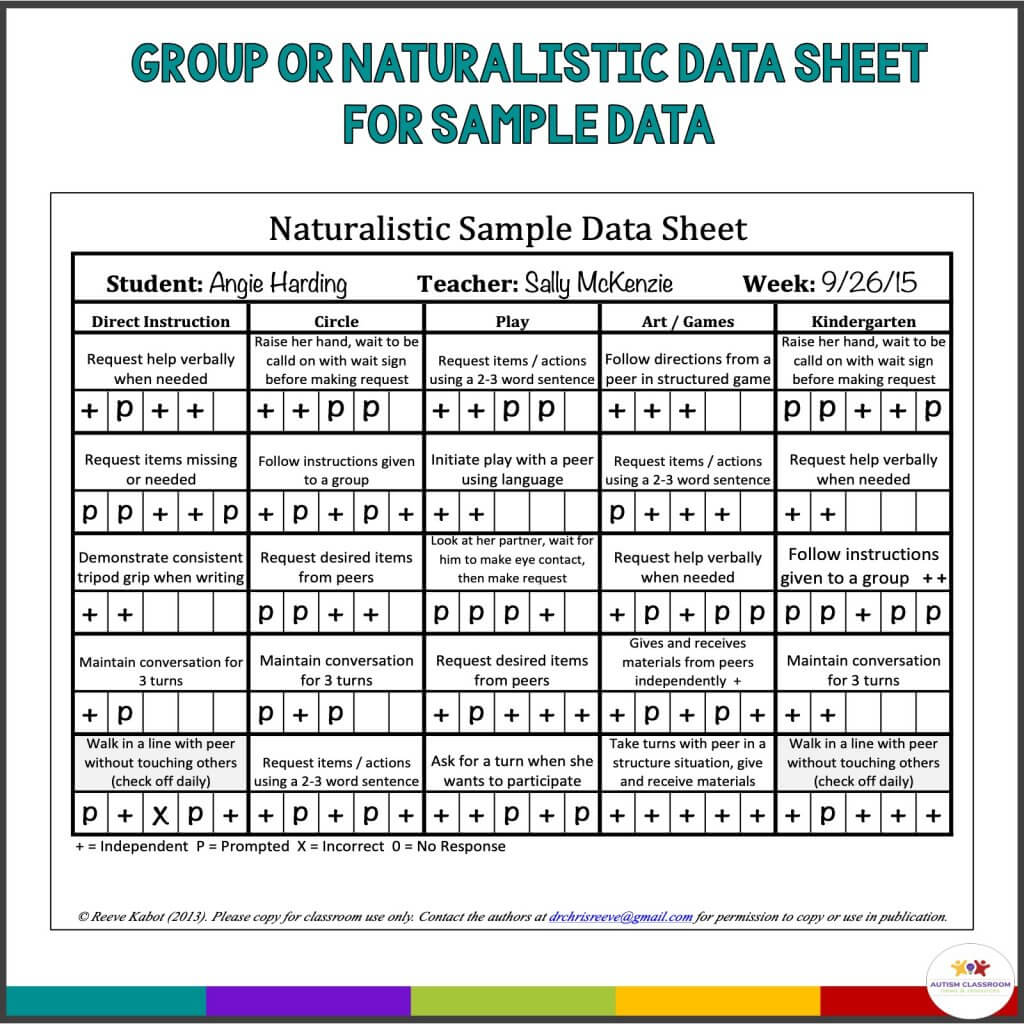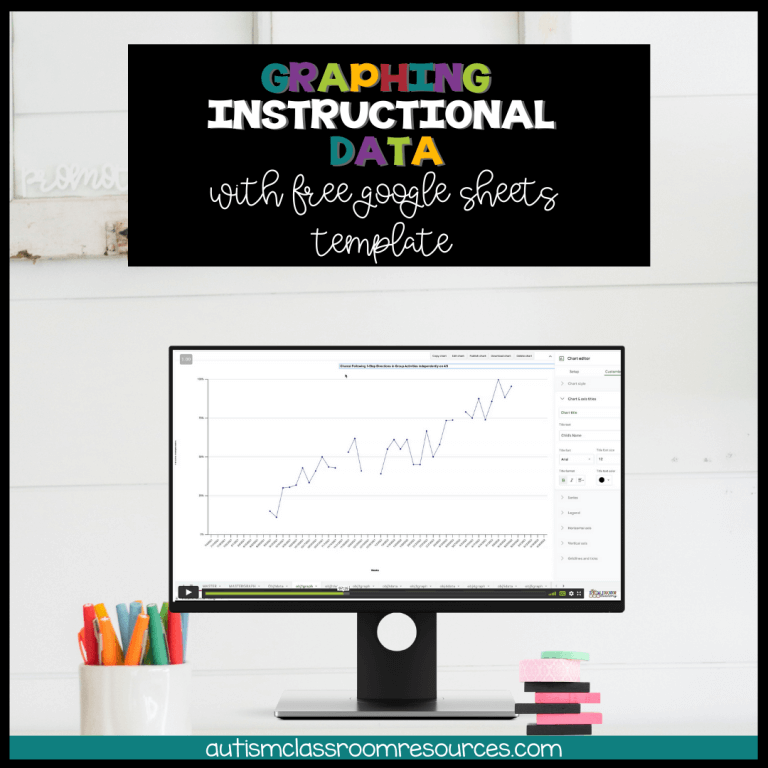With these sheets, you have the jumping off point to collect accurate and meaningful data so you are set for all the IEP meetings, progress reports, and parent communications. Let’s dive into how they can help you improve your IEP tracking process and answer some common questions about IEP data collection.
Imagine no more near-all-nighters to finish each student's progress report!
Table of Contents
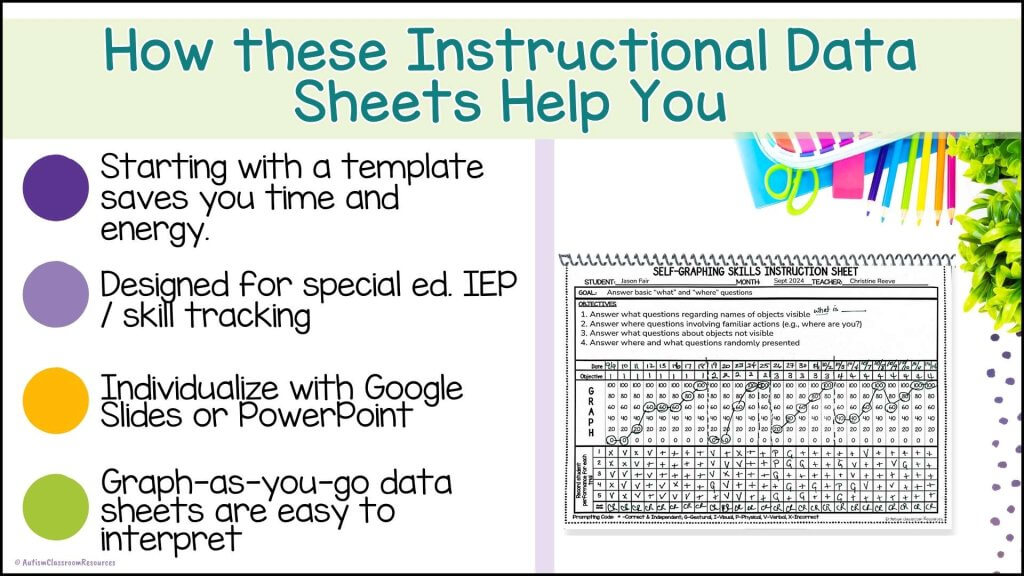
How Do You Collect Data for Special Education?
I’ve written about systems of data collection in the special education classroom in a previous podcast episode. And the key to effective progress monitoring and tracking IEP progress definitely involves putting a system for data collection in place. But what should you have in your system?
Collecting data in special education involves more than just checking off boxes—it’s about consistently tracking student progress in a way that reflects real growth over time. And it requires regular analysis of skills to determine if changes needs to be made in your instruction.
Whether you’re monitoring academic goals, behavior, or social skills, these IEP data collection sheets make it easy to gather the information you need. They’re customizable, so you can adjust them to fit each student’s specific goals.
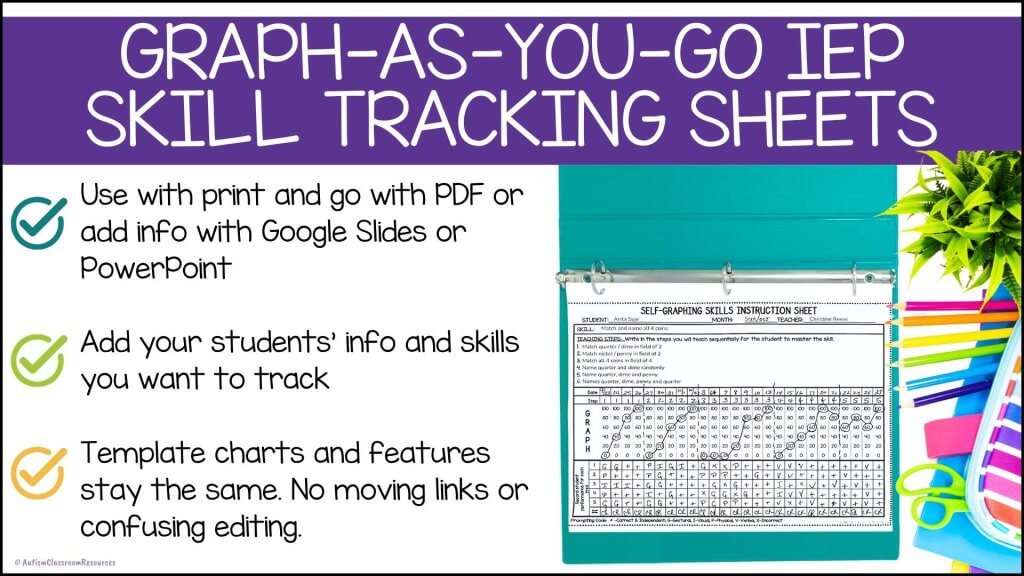
Some features include:
- Editable templates for customizing with individual student goals.
- Space to record daily, weekly, or monthly progress.
- Printable sheets that fit easily into binders or folders for quick access.
The ability to tailor these data collection sheets to each student’s IEP goals saves time and ensures that you’re capturing relevant, accurate data to inform your teaching strategies.
How to Record IEP Data with Ease
Recording IEP data is one of the biggest hurdles many special educators face. But it can be so much easier when you have examples that can be the right data sheet you need. With these editable IEP tracking sheets, you can efficiently document student progress while also easily interpreting the data to make instructional changes. These sheets allow you to:
- Track progress across multiple areas, including academic, social, and functional skills.
- Use probe data, event-by-event data, rubrics, work samples and more.
- Easily interpret your data regularly with graph-as-you-go data sheets.
Because the data collection tools are editable, you can adapt them to the unique needs of each student and classroom.
So let’s look at the two forms of data collection that I use to initially set up a system of data collection.
What Are the Two Primary Data Collection Strategies?
When tracking progress for students with disabilities, two highly effective data collection strategies that I use to set up classrooms are naturalistic probe data and trial-by-trial data. Each method has its benefits depending on the skill or behavior you’re tracking, and these editable IEP data collection sheets make both strategies easy to implement.

1. Naturalistic Probe Data
Naturalistic probe data is collected in a student’s everyday environment, and I sometimes refer to it as sample data. This strategy is a great way to take data in real-life situations where skills are being used. Probes could be daily or weekly depending on the skill and the need. So, it’s also terrific for tracking data on a group of students by sampling one student’s data each day. Consequently, works well for monitoring progress on skills like social interactions, communication skills, or generalizing academic knowledge.
Group / Probe Data Sheets
With these IEP data collection sheets, you can:
- Set up easy-to-use templates to record when a student independently uses a skill or what prompting was provided.
- Create group data sheets to track specific skills in activities like morning meeting or recess using weekly samples using 1 data sheet.
- Collect multiple trials of the skills as recommended by data collection research rather than just single or cold probes. This allows for better analysis of the data by having multiple points of data in each sample.
- The probe sheets each have 5 spots for data to be collected. This gives you more data to use to make decisions about students’ performance.

By focusing on what the student can do naturally, naturalistic probe data helps you make informed decisions about their ability to apply skills in different environments—an essential part of any IEP.
Plus you can grab a free data sheet for taking group data probe data in our Resource Library.
2. Trial-by-Trial Editable Data Sheets
For more structured skills or behaviors, trial-by-trial data is key. This method involves recording the student’s response during each instructional trial. It’s particularly useful for discrete skills that are taught in a step-by-step manner, such as academic tasks or behavior replacement strategies.

The best part? These editable IEP data sheets include a feature that allows you to graph results as you go! This means you can track the student’s progress in real-time, making it easy to spot trends and adjust your teaching strategies on the fly.
Some advantages of using trial-by-trial data with these sheets include:
- Monitoring every response the student makes, which is crucial for pinpointing where they might need additional support.
- Automatically generating visual graphs to represent the data, so you can see progress at a glance.
- Tailoring the sheets to fit each student’s specific goals and objectives.
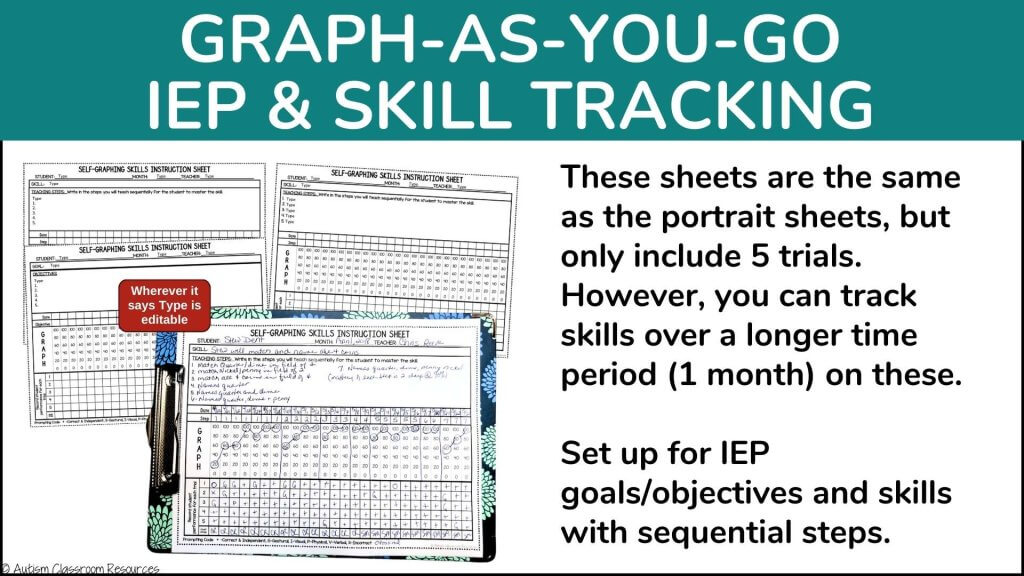
By combining both naturalistic probe data and trial-by-trial data, these data collection sheets provide a comprehensive way to track and measure student progress in a variety of settings.
More Types of Data Collection Tools Included
While those are the 2 primary types of data sheets I ise to set up a system of data collection in the classroom, there are a variety of ways to take data on different types of skills in the classroom. So, this bundle also includes other editable forms to track other students’ needs and specific skills. And all of the data come in editable form and printable versions.
Graph-As-You-Go Task Analysis Data Sheets
These sheets are perfect for functional life skills and daily routines where you are tracking specific steps fo a task. An example is included for teaching handwashing. So whether you are using shaping or chaining strategies, these data sheets will show your students’ progress across the steps of the skill. And with as you graph directly on the data sheet, it’s easy to track students’ progress and analyze the data.
Work Product Labels
One of my go-to tools in data collection is work product, sometimes called permanent product. Work product is the easiest way to take data because you rely on the student’s work to tell the story. No graphing, no analyzing needed. However, it’s important that you have critical information like what kind of prompting was provided, what type of situation were you in, etc. And that’s where work product labels come in.
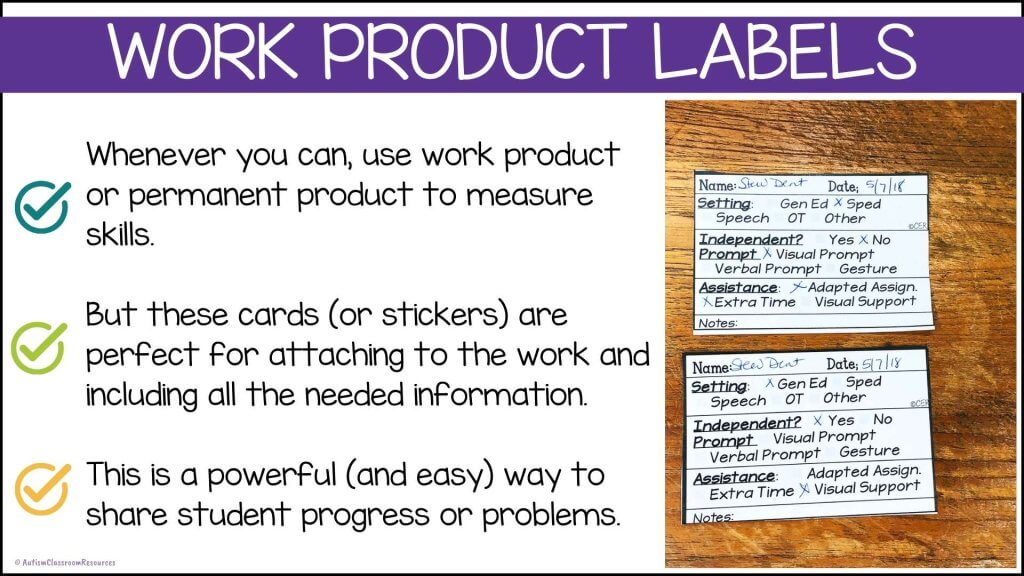
Print them on sticker paper (or simply tape them to the work sample itself) and have them ready for all the staff who help students with their work. Attach them directly to the work sample and save it for easy review with the IEP team members to make decisions about the student’s progress.
Rubrics Templates
Rubrics are another great way to take data on skills that don’t lend themselves to counting responses. Think about trying to take data on the quality of a student’s social interaction or conversation with a peer. We can count how many turns they take. But often we want to know things like how far away were they standing, did they appear to be attending when the other student spoke, were their responses on topic, etc.
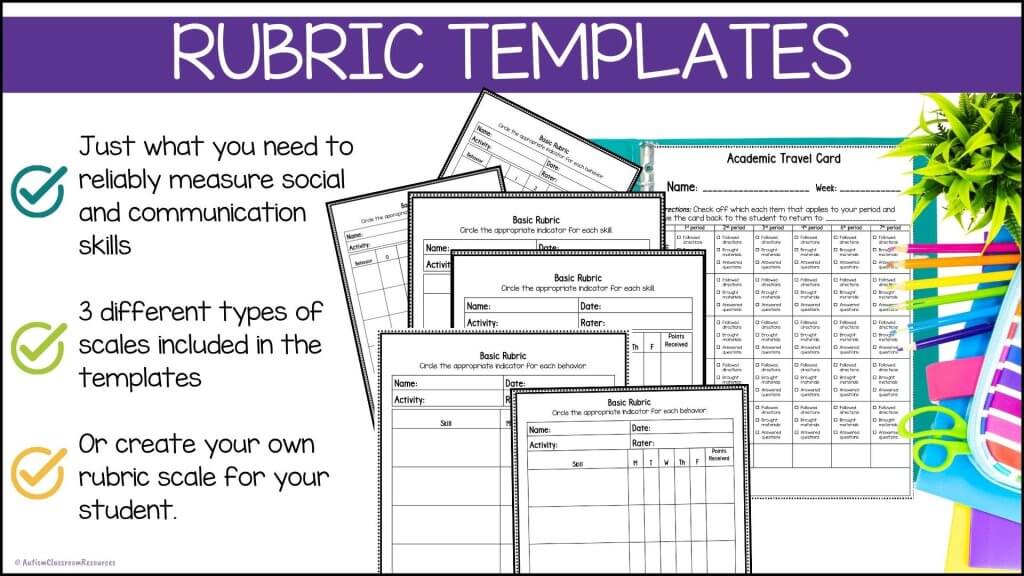
Rubrics, just like those we use for writing samples, are great for measuring the quality of the skill. So they are essential tools I use for tracking those types of skills. Because we are applying a number to their performance, we can easily graph the data points from the rubric to determine progress on the skill. I wrote more about rubrics and how I use them in this post.
Why These Editable IEP Data Collection Sheets Are a Game-Changer
These editable IEP data collection sheets aren’t just practical—they’re a true game-changer for simplifying how you track and interpret student progress. Here’s why:
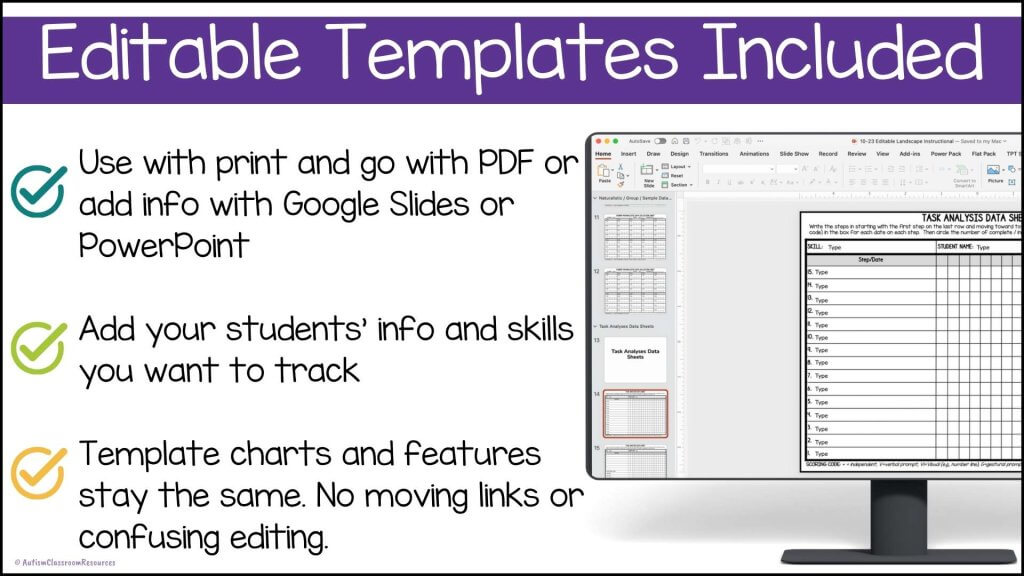
- Customizable: Easily modify the templates to fit each student’s unique IEP goals and objectives, so your data collection is always relevant.
- Easy to Use: Whether you prefer digital or printed formats, these sheets are simple to integrate into your daily routine.
- Comprehensive: Track everything from academic performance to behavior and social-emotional skills in one place.
- Graph-As-You-Go: The trial-by-trial data sheets come with a built-in option to graph progress in real time. This feature allows you to instantly visualize student growth, making it easier to identify patterns and make data-driven decisions without extra work.
These sheets offer the ultimate combination of flexibility, ease, and data visualization, giving you everything you need to stay informed—without the overwhelm.
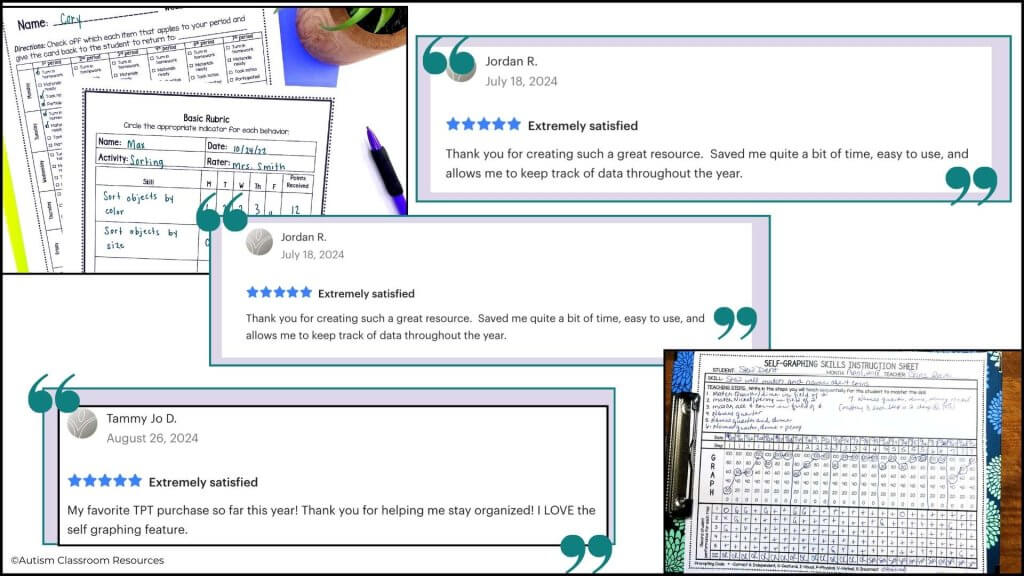
Ready to Simplify Your IEP Data Collection?
If you’re ready to make your life easier and improve your data collection for special education, grab these editable IEP goal tracking bundle here. They’re the perfect tool to ensure you’re tracking your students’ progress accurately and efficiently.
No more guessing or last-minute scrambles for data. These sheets will help you feel confident and prepared, whether you’re in an IEP meeting, updating progress reports, or just checking in on your students’ day-to-day growth.




